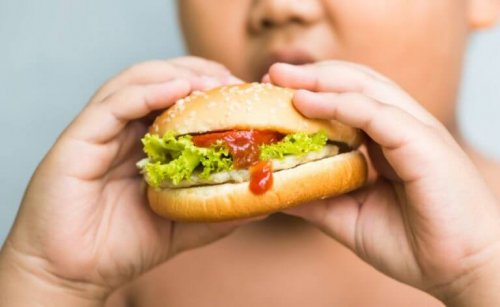Orthorexia: When Healthy Eating Goes too Far

Of course, you’ve heard of anorexia or bulimia. Beyond these two afflictions, there’s another eating disorder known as orthorexia. This disorder isn’t as well known.
The incidence of this eating disorder is increasing, most likely because of lifestyle choices. Due to the excessive preoccupation with body image, it’s becoming more common. Everyone knows about anorexia and bulimia, but other disorders are also becoming more widespread. We are referring to not only orthorexia but to bigorexia or vigorexia as well.
Types of food disorders
Anorexia
Those with anorexia reject food as part of their illness and have an obsessive fear of becoming overweight. Consequently, a person can reach a state of starvation. Generally, this psychological illness affects young women, even though more and more men are also suffering from this condition too.
There are two subcategories of anorexia, depending on the person. One of them is when the person voluntarily refrains from eating. This is a typical symptom of anorexia. On the other hand, another person may binge eat and then compensate with other actions. The person might take laxatives and/or vomit in order to purge. This is a purgative or a compulsive type of anorexia.
Bulimia: a form of orthorexia
The characteristics of bulimia include constant food binging and inappropriate methods to avoid gaining weight.

“A binge is characterized as eating a lot of food in a short period of time. For example, this includes eating a large amount of food in a period of two hours. And, this would be a much larger quantity than other people would consume in the same circumstances. While doing this, there would be a feeling of loss of control over the type and quantity of food that a person is eating.”
_Mijan de la Torre_
Vomiting
This is also known as vomiting syndrome. Differing from the above conditions, people compulsively eat and then vomit at various times of the day. Clearly, they feel the uncontrollable impulse to eat in order to vomit.
Miscellaneous eating disorders
This topic includes a group of disorders that don’t fall into the category of any specific eating disorder. For instance, this can include bulimic behavior with binges that are less frequent
Vigorexia: another form of orthorexia
The other name for vigorexia is the Adonis Complex. This psychological condition is different from the above because it’s not specifically a food disorder. However, it does share some of the same symptoms such as the obsession with the body shape and distortion of the body image. With vigorexia, there’s an obsessive preoccupation with musculature.
PICA
The illness of PICA causes individuals to ingest non-food items. For example, this may be dirt or paper.
Regurgitation
Also called merycism, this is the repeated regurgitation of food from the stomach to the mouth. This is when food is expulsed or chewed indefinitely.
Obesity: a type of orthorexia
The increase in this multi-aspect pathology is very common today. Especially common in people in states of depression or anxiety, it’s a continual increase in weight. In addition, it means an increase in eating in a compulsive way. Consequently, it can be a result of bulimia or binge eating that causes weight gain.

Orthorexia
Orthorexia has been recently described. To explain, it’s an excessive preoccupation with diet. As a result, it can cause social isolation and a strict diet regimen.
The pathological obsession with diet tends to start innocently and maybe a desire for better health. Also, it could be with the intention of losing weight or curing a disease. What to eat, how much, and the consequences of a poor diet are things that an orthorexic has in mind.
This preoccupation with healthy food also includes agricultural ecology. Obviously, this means food that’s free of pesticides and GMOs. Sometimes this can imply consuming only one food group, creating deficits in other food groups and nutrition.
Symptoms of orthorexia
Even though diagnostic criteria isn’t yet confirmed, there are some common characteristics:
- Dedicating more than three hours a day to a healthy diet
- Worrying more about the quality of food than the pleasure of eating it
- Feeling guilty if a strict diet is not followed
- Excessive planning of the diet for the next day
- Social isolation caused by diet
- Driving great distances to source special foods
Incidence of orthorexia
Currently, we don’t know the prevalence of orthorexia. However, in the Bratman Manual about orthorexia, it estimates that approximately 5,000 people in the US have suffered from this illness.

How do we treat orthorexia?
The psychological treatment for orthorexia is more costly than nutritional treatment. Without a doubt, it’s more difficult to eliminate the orthorexic behavior that the person has adopted for an extended period of time.
As always, the first step in treatment is accepting the problem on the part of the sufferer. In addition, the person needs to have the desire to end the obsession. It’s important that during this process, the subject receives treatment from an interdisciplinary team. Also, it needs to be from a cognitive-behavioral orientation.
Of course, you’ve heard of anorexia or bulimia. Beyond these two afflictions, there’s another eating disorder known as orthorexia. This disorder isn’t as well known.
The incidence of this eating disorder is increasing, most likely because of lifestyle choices. Due to the excessive preoccupation with body image, it’s becoming more common. Everyone knows about anorexia and bulimia, but other disorders are also becoming more widespread. We are referring to not only orthorexia but to bigorexia or vigorexia as well.
Types of food disorders
Anorexia
Those with anorexia reject food as part of their illness and have an obsessive fear of becoming overweight. Consequently, a person can reach a state of starvation. Generally, this psychological illness affects young women, even though more and more men are also suffering from this condition too.
There are two subcategories of anorexia, depending on the person. One of them is when the person voluntarily refrains from eating. This is a typical symptom of anorexia. On the other hand, another person may binge eat and then compensate with other actions. The person might take laxatives and/or vomit in order to purge. This is a purgative or a compulsive type of anorexia.
Bulimia: a form of orthorexia
The characteristics of bulimia include constant food binging and inappropriate methods to avoid gaining weight.

“A binge is characterized as eating a lot of food in a short period of time. For example, this includes eating a large amount of food in a period of two hours. And, this would be a much larger quantity than other people would consume in the same circumstances. While doing this, there would be a feeling of loss of control over the type and quantity of food that a person is eating.”
_Mijan de la Torre_
Vomiting
This is also known as vomiting syndrome. Differing from the above conditions, people compulsively eat and then vomit at various times of the day. Clearly, they feel the uncontrollable impulse to eat in order to vomit.
Miscellaneous eating disorders
This topic includes a group of disorders that don’t fall into the category of any specific eating disorder. For instance, this can include bulimic behavior with binges that are less frequent
Vigorexia: another form of orthorexia
The other name for vigorexia is the Adonis Complex. This psychological condition is different from the above because it’s not specifically a food disorder. However, it does share some of the same symptoms such as the obsession with the body shape and distortion of the body image. With vigorexia, there’s an obsessive preoccupation with musculature.
PICA
The illness of PICA causes individuals to ingest non-food items. For example, this may be dirt or paper.
Regurgitation
Also called merycism, this is the repeated regurgitation of food from the stomach to the mouth. This is when food is expulsed or chewed indefinitely.
Obesity: a type of orthorexia
The increase in this multi-aspect pathology is very common today. Especially common in people in states of depression or anxiety, it’s a continual increase in weight. In addition, it means an increase in eating in a compulsive way. Consequently, it can be a result of bulimia or binge eating that causes weight gain.

Orthorexia
Orthorexia has been recently described. To explain, it’s an excessive preoccupation with diet. As a result, it can cause social isolation and a strict diet regimen.
The pathological obsession with diet tends to start innocently and maybe a desire for better health. Also, it could be with the intention of losing weight or curing a disease. What to eat, how much, and the consequences of a poor diet are things that an orthorexic has in mind.
This preoccupation with healthy food also includes agricultural ecology. Obviously, this means food that’s free of pesticides and GMOs. Sometimes this can imply consuming only one food group, creating deficits in other food groups and nutrition.
Symptoms of orthorexia
Even though diagnostic criteria isn’t yet confirmed, there are some common characteristics:
- Dedicating more than three hours a day to a healthy diet
- Worrying more about the quality of food than the pleasure of eating it
- Feeling guilty if a strict diet is not followed
- Excessive planning of the diet for the next day
- Social isolation caused by diet
- Driving great distances to source special foods
Incidence of orthorexia
Currently, we don’t know the prevalence of orthorexia. However, in the Bratman Manual about orthorexia, it estimates that approximately 5,000 people in the US have suffered from this illness.

How do we treat orthorexia?
The psychological treatment for orthorexia is more costly than nutritional treatment. Without a doubt, it’s more difficult to eliminate the orthorexic behavior that the person has adopted for an extended period of time.
As always, the first step in treatment is accepting the problem on the part of the sufferer. In addition, the person needs to have the desire to end the obsession. It’s important that during this process, the subject receives treatment from an interdisciplinary team. Also, it needs to be from a cognitive-behavioral orientation.
All cited sources were thoroughly reviewed by our team to ensure their quality, reliability, currency, and validity. The bibliography of this article was considered reliable and of academic or scientific accuracy.
- Miján de la Torre A. Nutrición y metabolismo en trastornos de la conducta alimentaria. Cap 3: Velasco Vallejo JL, Martín de la Torre E. Clasificación de los trastornos de la alimentación. La obesidad como trastorno de la alimentación. Editorial Glosa; 2004. p.57-69
- Nardone G, Verbito T, Milanese R. Las prisiones de la comida. Cap 1.2: Clasificación diagnóstica de los trastornos alimentarios. Barcelona. Editorial Herder; 2002
- Bratman S, Knight D. Health Food Junkies. Orthorexia nervosa: overcoming the obsession with healthful eating. 1ª ed. Estados Unidos: Broadway Books; 2000
- Dávila, S.G., García, G.I., Mata, H.J et al. ¿Comer sano es siempre algo bueno? 2005. http://www.monografias.com/trabajos29/ortorexia/ortorexia.shtml.
- Diagnostic and Statistical Manual of Mental Disorders: DSM-IV-TR. Washington, DC: American Psychiatric Association; 2000
This text is provided for informational purposes only and does not replace consultation with a professional. If in doubt, consult your specialist.








